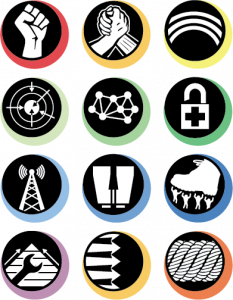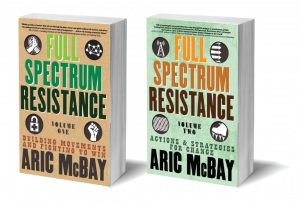I began my activist career as a young liberal environmentalist. I was the founding president of my environment club in elementary school. I gave speeches about saving the whales. I wrote and acted in a play about the dangers of environmental destruction, in which a selfish CEO was sent to the future to face the consequences of his acts. Our group set up composters, sold reusable Tupperware lunch kits so that people could reduce their waste, and raised money to adopt acres of the Amazon rainforest.
I knew these were small gestures, but as a young person I believed that if we could just convince and educate enough people we would turn things around.
When I was in high school, our environmental club ran a bottle-and-can-recycling program. There wasn’t a proper municipal recycling program in place yet, so we had to sort and wash the bottles ourselves and arrange for their pick up. Other students—ignoring our polite signs and pleas to be neat—would dump half-full pop bottles and garbage into our clearly marked recycling bins. Friday night after school was the time to organize and wash the week’s bottles and cans. We would hose off the bins as we picked out plastic straws and soggy napkins. The spray generated a fine aerosol mist, a dilute fog of high-fructose corn syrup. I remember the way it stuck to my skin, how it beaded on my forearms like sugary dew. We didn’t care—we did it for the planet.
Late one spring another environmental group I was part of organized a weekend conference for students. We had speakers on all sorts of subjects: water quality, solar power, boycotting Nestlé, and the benefits of growing hemp. But the presentation I remember most clearly—the people I will never forget—was from a group from the Ojibwe community of Grassy Narrows (Asabiinyashkosiwagong Nitam–Anishinaabeg). They were—by rather loose northern Ontario standards—our neighbors, although they had driven for ten hours to come to our conference.
The Grassy Narrows representatives were of many different ages. The younger people went swimming with us in chilly little lakes. The older people were their speakers; they told us the story of their community, and of how it had been poisoned.
Like most of northern Ontario, the land around Grassy Narrows had been forest since the last ice age. Industrial activity—especially logging and the associated pulp and paper mills—metastasized into the area after World War II. In the 1950s, Grassy Narrows’ territory was flooded by the government for hydroelectric dams, forcing people to relocate.
In 1962, the Dryden Chemical Company opened a chloralkali plant nearby. The chloralkali plant was built to produce sodium hydroxide and chlorine for bleaching paper. This process is energy intensive—hence the hydroelectric dams—but the factory also used large amounts of mercury for processing, and its effluent was dumped directly into the river system.
If you look at a satellite photo of northwestern Ontario you will see two things: forests and lakes. In the area around Grassy Narrows there are thousands upon thousands of lakes and islands. There is hardly a place that can’t be reached by canoe and paddle.
So for a very long time the people of Grassy Narrows had relied on fish for food. When the reservations were imposed and settlers moved in, many Ojibwe used their excellent fishing skills as a source of income. They had to deal with the flooding of their land, with racism and relocation, and with the horrors of the residential schools. But there were always fish.
In the late 1960s, people in Grassy Narrows (and neighboring Whitedog First Nation) started to get sick. Some of them had trouble speaking. Their hearing and vision began to fail. Walking became difficult. Their hands began to shake with tremors. People who had expertly tied the tiniest knots in fishing line for decades could barely tie their own shoelaces.
It soon became clear that mercury was the culprit. Doctors brought in from Japan identified the illness as Minamata disease, a form of severe mercury poisoning named after the city in Japan where a similar mass poisoning had been caused by a different factory. In 1970, the government forbid the Dryden Chemical Company to release mercury into the water, though it continued to be released into the air.
The chloralkali plant dumped at least nine thousand kilograms of mercury into the water between 1962 and 1970.2 The Dryden Chemical Company shut down in 1976. But the poisoning of the land was permanent. Contamination extended through the waterways more than 250 kilometers downstream over an enormous watershed.3 Cleanup was essentially impossible—there is simply no way to remove that much mercury from such a large area.4 It wasn’t just humans and fish affected, of course. The many lakes and rivers are home to wild rice, waterfowl, amphibians, beavers and other living creatures.
Grassy Narrows won a financial settlement sixteen years after the mercury poisoning was identified. The total amount was a mere $10,000 per person, meant to compensate them for the destruction of the land base and, in many cases, their own bodies.5 But very little of that paltry amount actually made it to members of the community. Bureaucratic red tape was an obstacle.6 So were Band Councils, supposedly representative bodies which have been imposed on First Nations by the Canadian government, but which are often dysfunctional and which many Indigenous people despise as tools of colonialism.
In recent decades, contamination of the waterways has been worsened by clear-cutting around Grassy Narrows which caused major soil erosion. Mercury that had been immobilized in the soil was washed back into the waterways.7 One of the major struggles at Grassy Narrows became the fight to stop clear-cutting on their lands, clear-cutting sanctioned and licensed by the state.
The visitors from Grassy Narrows explained these things to us. They explained how the government continued to ignore their needs, and continued to destroy their land and water, despite every reasonable and polite attempt by the Ojibwe to assert themselves. I don’t remember them using the words racism or genocide, but both were clearly at work.
The conference ended. The settler students went back to their homes, and the Indigenous to theirs. The next Friday came, and it was time to wash the recycling again. I remember the afternoon clearly. It was hot, which made the cloud of fructose spray even stickier. I pulled a used napkin out of a juice bottle for the umpteenth time. But instead of throwing it in the trash, I paused. I stared at its bleached white fibers. And I began to understand why our environmental activism wasn’t working.
That napkin helped me to grasp that environmental destruction wasn’t really about lack of education. It wasn’t about misunderstandings. It wasn’t about technology that was more (or less) damaging. It was about power.
Somewhere not far away was a group of Indigenous people I had sat with, eaten with, spoken with, whose vast land base had been poisoned and clear-cut to produce napkins like the one I held in my hand. A napkin which was used for a few minutes—or not at all—and then discarded without thought. The student who had thrown out this napkin didn’t do so because they wanted to make a personal choice to destroy someone else’s land base. (And if they had individually refused to use that napkin it would have made no visible difference.) They did it because they were part of a system of power, a system in which they benefited from the destruction of someone else’s land. And in which they had the privilege to be totally ignorant of that impact. They had power.
Our Indigenous friends, in contrast, had very little power in the economic and political systems of colonial Canada. Worse than that, the very existence of Canada was due to the fact that their lands, and the lands of many cultures, had been stolen. (Most of Canada consists of land which was unceded, or for which treaties were coerced, or for which treaties were signed but not honored by settlers.)
Our environmental group had not gained very much traction with the student body. Before that conference I had believed that with enough hard work, public education, and awareness-raising we could convince people to give up some of their convenience and privilege to save the planet. But I began to grasp that perhaps we had it backward: it was their power and privilege that allowed them to ignore public education. They didn’t care about environmental awareness because it was someone else’s land they were destroying. They could always pretend that things were fine, because they would never be the ones who had to suffer the consequences of their actions—at least, not until it was too late.


